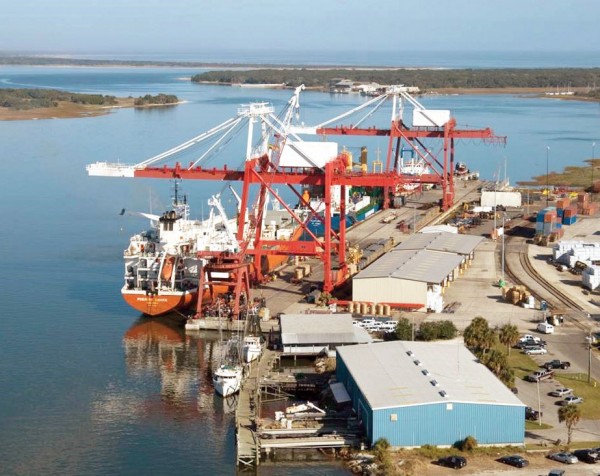Ports along the Atlantic Coast of Florida are continuing to meet demands of growing commerce by advancing a bevy of infrastructure enhancements, including deeper ship channels.
From new berths to improved intermodal links, the wealth of endeavors at seaports of the Sunshine State’s East Coast aim to facilitate swift, efficient handling of increasing cargo volumes.
Port of Fernandina
Florida’s northernmost port, the Port of Fernandina, has just changed hands with acquisition of longtime operator Nassau Terminals LLC, a unit of Kinder Morgan Port Terminals LLC, by Worldwide Terminals Fernandina LLC, a subsidiary of Worldwide Group LLC and Four Wood Infrastructure Partners. The latter is a subsidiary of Four Wood Capital Partners LLC, a New York-based asset management and merchant banking firm.

The port currently handles paper and other forest product exports to the Caribbean and Central and South America by Barnett Paper and Caribbean Forest Carriers and is in its 32nd year as homeport for Somers Isles Shipping Ltd.’s containership service to Bermuda.
Port of Jacksonville
After a decade of study, public input and reviews, and having gained full regulatory approval, deepening of Jacksonville Harbor to 47 feet has begun by Dutra Group, under contract with the U.S. Army Corps of Engineers, with the first 3-mile segment of work expected to take two years.

The Jacksonville Port Authority’s FTZ No. 64 opened an outdoor storage facility in February, and JAXPORT has recently augmented its staff with the January hirings of veteran PortMiami executive Frederick P. Wong Jr. as chief operating officer and David Kalata, most recently international sales manager for Florida East Coast Railway, as director of national container accounts.
Port Canaveral
With late 2017 completion by Dutra Group of the $7.5 million, state-grant-backed project to deepen its West Turning Basin to 43 feet plus 2 feet of additional overdredge, Central Florida’s Port Canaveral now boasts ability to safely accommodate larger vessels at its containerized cargo terminal, operated at North Cargo Berth 5 and 6 by GT USA.

January marked the first call at Port Canaveral of supersized post-Panamax ships, with Mitsui O.S.K. Lines’ Brooklands car carrier, offering capability to transport more than 7,400 vehicles, arriving from Asia at the AutoPort Canaveral LLC facility after transit through expanded Panama Canal locks.
Port of Palm Beach
Having finished the $18.5 million redevelopment of its Slip 3, the Port of Palm Beach, located in Riviera Beach, is methodically advancing a $12 million project to build a new minislip at Berth 17, to accommodate stern-in mooring of a 350-foot-long roll-on/roll-off vessel. With additional dolphin structure work being required, the Feb. 15 substantial completion date for the Berth 17 project has had to be extended.

A nearly $1 million endeavor is moving toward projected August completion of the first phase of expansion of the on-port rail facility at the Port of Palm Beach, which in its fiscal year ended Sept. 30, 2017, handled 9 percent more railcars than in the preceding 12-month period.
Port Everglades
In South Florida’s Broward County, new cargo berths and super-post-Panamax gantries are in store for the Port Everglades Southport Container Complex. The $437.5 million expansion, the largest project in the port’s history, is designed to deliver as many as five new cargo berths by lengthening the existing Southport Turning Notch to 2,400 feet from 900 feet. The undertaking, including installation of crane rail infrastructure to support super-post-Panamax gantries, is projected for completion by 2021. The port has three such big cranes on order, for $13.8 million apiece, with an option to buy three more.

Also, Port Everglades in January inked a fresh long-term lease with Horizon Terminal Services LLC, which is investing $630,000 in a new vehicle-processing facility.
PortMiami
With the past few years having brought completion of channel deepening to 50 feet (plus 2 feet of overdredge), establishment of on-dock Florida East Coast Railway intermodal rail service and opening of the PortMiami Tunnel under Biscayne Bay, Miami-Dade County’s PortMiami is living up to its “big-ship ready” promise thanks to more than $1.3 billion in infrastructure investments.

While realizing moves of containerized cargo at an annual pace of 1 million TEUs, PortMiami, formally known as the Dante B. Fascell Port of Miami, also continues to uphold its trademarked status as Cruise Capital of the World, with recent passenger terminal expansions and more than 5 million handlings a year of multiday cruisers.
Port of Miami River
The Miami River, with its 15-foot-deep navigational channel, has for decades provided comparatively small shipping companies an important link to shallow-draft ports of the Caribbean, most notably those of the Dominican Republic and Haiti, and a new study now indicates prospects for significantly greater cargo activity along the downtown Miami waterway.

The plan cites several matters that may need to be addressed to facilitate more Miami River ship traffic, including improved road, rail, marine and intermodal connections; better terminal truck staging; and development of a truck service facility. The recent inclusion of the Miami River in FDOT’s Strategic Intermodal System program has made the river port eligible for state and federal funding that could give such enhancements a jumpstart.






